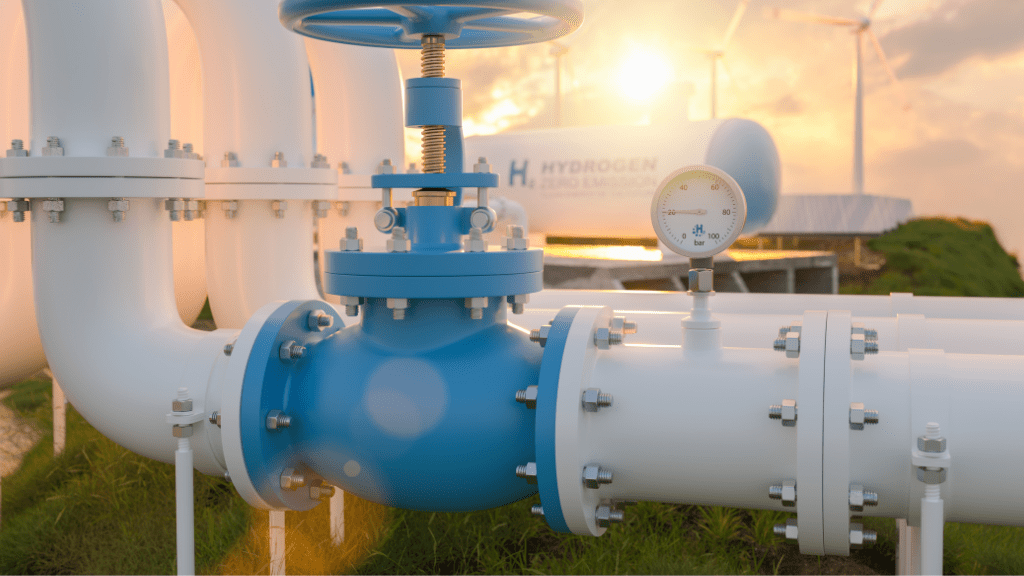If you are interested in hydrogen and hydrogen as a fuel, read on to learn some interesting hydrogen facts. Based on common search queries and online discussions, most people seem to be interested in the following aspects of hydrogen fuel:
- Applications and uses: Many people are curious about the different ways that hydrogen can be used, such as in fuel cells for transportation and stationary power generation, in industrial processes, and as a feedstock for chemical production.
- Advantages and disadvantages: People want to know the benefits and drawbacks of using hydrogen as a clean energy source, including its efficiency, cost, safety, and environmental impact.
- Production and storage: There is interest in the various methods used to produce hydrogen, including steam methane reforming, electrolysis, and biomass gasification, as well as the different ways that hydrogen can be stored, such as in high-pressure tanks or cryogenic containers.
- Infrastructure: There is growing interest in the development of a hydrogen infrastructure, including the availability of refueling stations, pipelines, and storage facilities, as well as the challenges associated with building and maintaining such infrastructure.
- Future prospects: People are interested in the potential role that hydrogen could play in the transition to a low-carbon economy, including its potential impact on greenhouse gas emissions, energy security, and economic growth. There is also interest in the future of hydrogen technology, including advancements in fuel cells and hydrogen production methods.
What are the different ways that hydrogen can be used?
Hydrogen can be used in a variety of ways, including:
- Fuel cells: Hydrogen fuel cells are a clean and efficient way to generate electricity, with applications in transportation and stationary power generation. Fuel cells convert hydrogen gas and oxygen into electricity, with only water and heat as byproducts.
- Transportation: Hydrogen can be used as a fuel for vehicles, including cars, buses, and trucks. Hydrogen fuel cell vehicles are already being produced and used in some parts of the world.
- Stationary power generation: Hydrogen fuel cells can be used to generate electricity for stationary power generation applications, such as in backup power systems, remote power systems, and microgrids.
- Industrial processes: Hydrogen is used as a feedstock in a range of industrial processes, including oil refining, ammonia production, methanol production, and steel production.
- Chemical production: Hydrogen is used as a feedstock in the production of a range of chemicals, including fertilizers, plastics, and synthetic materials.
- Energy storage: Hydrogen can be used as a means of storing excess energy from renewable sources, such as solar and wind power, for later use when demand is higher.
- Heating and cooling: Hydrogen can be used as a fuel for heating and cooling systems, such as in residential and commercial buildings, through the use of fuel cell-powered boilers and air conditioning systems.
Overall, the versatility of hydrogen makes it a promising energy carrier with a wide range of potential applications across various sectors of the economy.
What are the advantages and disadvantages of hydrogen?
Advantages of hydrogen as a clean energy source:
- Clean and Renewable: Hydrogen is a clean and renewable energy source that does not produce harmful emissions or pollutants when burned or used in fuel cells.
- High Energy Density: Hydrogen has a very high energy density, meaning that a relatively small amount of hydrogen can provide a large amount of energy.
- Versatile: Hydrogen is a versatile energy carrier that can be used in a range of applications, from transportation to power generation to industrial processes.
- Efficient: When used in fuel cells, hydrogen can be converted into electricity with high efficiency, making it an attractive option for powering vehicles and other devices.
- Scalable: Hydrogen production and storage can be scaled up or down as needed to meet varying energy demands.
Disadvantages of hydrogen as a clean energy source:
- Cost: The cost of producing and storing hydrogen is currently higher than that of conventional fossil fuels, making it less competitive in some markets.
- Safety: Hydrogen is highly flammable and can be explosive in certain conditions, requiring careful handling and storage procedures.
- Infrastructure: A lack of infrastructure for hydrogen storage and distribution is a major barrier to the widespread adoption of hydrogen as a fuel.
- Environmental Impact: Although hydrogen itself is a clean fuel, the process of producing hydrogen from fossil fuels can produce greenhouse gas emissions, contributing to climate change.
- Efficiency: The process of producing hydrogen can be energy-intensive, which can reduce the overall efficiency of using hydrogen as a clean energy source.
In summary, while hydrogen has many potential advantages as a clean energy source, there are also significant challenges that must be addressed to realize its full potential as a sustainable energy carrier.
How is hydrogen made?
There are several methods used to produce hydrogen, including:
- Steam Methane Reforming: This is currently the most common method for producing hydrogen, accounting for around 95% of global production. It involves reacting natural gas with steam to produce hydrogen and carbon dioxide.
- Electrolysis: This method uses an electric current to split water into hydrogen and oxygen. There are two types of electrolysis – alkaline and proton exchange membrane (PEM) – with PEM electrolysis being the most commonly used for hydrogen production.
- Biomass Gasification: This method involves heating biomass (such as wood or agricultural waste) in a low-oxygen environment to produce a mixture of hydrogen, carbon monoxide, and other gases. The hydrogen can be separated from the gas mixture and purified for use.
- Solar Hydrogen Production: This method uses solar energy to power the electrolysis of water, producing hydrogen and oxygen.
How is hydrogen stored?
Hydrogen can be stored in several ways, including:
- Compressed Gas Storage: Hydrogen can be stored in high-pressure tanks at pressures of up to 700 bar.
- Liquid Hydrogen Storage: Hydrogen can be stored as a cryogenic liquid at very low temperatures (-253°C).
- Metal Hydride Storage: Hydrogen can be stored in solid form using metal hydrides that absorb and release hydrogen.
- Chemical Hydride Storage: Hydrogen can be stored in solid form using chemical compounds that release hydrogen when heated or reacted with a catalyst.
- Carbon-based Materials: Hydrogen can also be stored in carbon-based materials such as graphene, carbon nanotubes, and activated carbon.
Overall, the choice of hydrogen production method and storage technique depends on a range of factors, including cost, efficiency, safety, and environmental impact, as well as the specific application for which the hydrogen will be used.
Hydrogen infrastructure: What storage and transportation systems are needed?
There has been growing interest in expanding hydrogen infrastructure for transportation and other applications, particularly in countries that have set ambitious targets for reducing greenhouse gas emissions. For example, several countries, including Japan, South Korea, and Germany, have announced plans to develop hydrogen infrastructure networks, with a focus on building out refueling stations for hydrogen-powered vehicles.
One of the main challenges associated with building and maintaining hydrogen infrastructure is the high cost and complexity of the necessary equipment and systems. For example, hydrogen refueling stations require specialized equipment to compress, store, and dispense hydrogen, as well as safety measures to prevent leaks and accidents.
In addition, there are logistical challenges associated with transporting and storing hydrogen, which is a highly flammable and volatile gas. This requires careful handling and storage procedures, as well as specialized equipment for transporting and storing hydrogen in compressed or liquid form.
Another challenge is the lack of standardized regulations and codes for hydrogen infrastructure, which can create barriers to cross-border trade and investment in hydrogen technology. This is particularly relevant for hydrogen transportation, which requires coordinated efforts among different countries and regions to establish common standards and regulations for transporting and storing hydrogen safely and efficiently.
Despite these challenges, there is growing momentum behind the development of hydrogen infrastructure, with governments, industries, and investors recognizing the potential of hydrogen as a clean and versatile energy source. As such, significant investments are being made to overcome the challenges associated with building and maintaining hydrogen infrastructure, and to accelerate the deployment of hydrogen technologies at scale.
How can hydrogen help transition to a low-carbon economy?
Hydrogen is seen as a key component of the transition to a low-carbon economy because it has the potential to reduce greenhouse gas emissions, improve energy security, and drive economic growth in a sustainable manner.
One of the main advantages of hydrogen is that it can be produced from a variety of low-carbon or renewable energy sources, such as solar, wind, and hydroelectric power. This means that hydrogen can be used to decarbonize a wide range of sectors, including transportation, industry, and buildings, by replacing fossil fuels with clean hydrogen.
When hydrogen is produced from renewable sources, such as electrolysis powered by wind or solar energy, it is known as green hydrogen. Green hydrogen is completely carbon-free and has the potential to significantly reduce greenhouse gas emissions in sectors that are difficult to decarbonize using other technologies, such as heavy-duty transportation and industrial processes.
In addition, hydrogen can help to improve energy security by reducing reliance on imported fossil fuels, which are subject to price volatility and geopolitical risks. By developing domestic hydrogen production and supply chains, countries can increase their energy independence and reduce their exposure to supply disruptions.
Moreover, the development of a hydrogen economy can create new economic opportunities and drive sustainable economic growth. For example, the production, storage, transportation, and distribution of hydrogen requires significant investments in infrastructure, equipment, and skilled labor, which can create jobs and support local economies. In addition, the export of hydrogen and hydrogen-related technologies can create new markets and trade opportunities.
However, there are also challenges associated with the widespread adoption of hydrogen, including the high cost of infrastructure and the need for supportive policies and regulations to incentivize investment and deployment. Furthermore, there are concerns about the environmental impact of hydrogen production, particularly when hydrogen is produced from fossil fuels using carbon capture and storage technology, which is still in the early stages of development.
Overall, hydrogen is seen as a promising clean energy source that can play a key role in the transition to a low-carbon economy, but its full potential will depend on continued innovation, investment, and collaboration across government, industry, and civil society.
Top 10 hydrogen facts you need to know
- Hydrogen is the lightest and most abundant element in the universe, making up about 75% of all matter.
- Hydrogen is a highly flammable gas that can easily ignite in air, making it useful as a fuel for rockets and as a component of fuel cells.
- Hydrogen has the highest energy content per unit of weight of any fuel, making it an attractive option for clean energy production.
- Hydrogen gas is odorless, colorless, and tasteless, and has no toxic effects on the human body.
- Hydrogen can exist as a solid, liquid, or gas depending on the temperature and pressure conditions.
- Hydrogen has been used for a variety of industrial purposes, including the production of ammonia, methanol, and other chemicals.
- Hydrogen has the potential to be a carbon-free energy source, as it can be produced from renewable sources such as wind and solar power.
- Hydrogen fuel cells have been developed for use in electric vehicles and other applications, offering a clean and efficient energy alternative.
- Hydrogen can react with many other elements, forming a wide range of compounds, including water, acids, and organic compounds.
- Hydrogen was first discovered by Henry Cavendish in 1766, but its properties were not fully understood until the 20th century.
Little known facts that most people do not know about hydrogen
- Hydrogen has the highest thermal conductivity of all gases, which means it can transfer heat more efficiently than any other gas.
- Hydrogen has the lowest boiling point of all elements, at just -252.87°C, which makes it the first element to become a liquid when it is cooled.
- Hydrogen gas can be produced by some species of bacteria through a process called hydrogenogenesis, which occurs in the gut of some animals, including humans.
- Hydrogen is the only element that can exist in three different isotopic forms: protium, deuterium, and tritium.
- Hydrogen fuel cells were first used in space missions in the 1960s, and have been used in all subsequent manned and unmanned missions by NASA.
- Hydrogen can be used to store energy in the form of chemical bonds, which can be later released and used to produce electricity.
- Hydrogen has been proposed as a fuel for nuclear fusion, which could potentially provide an almost limitless source of clean energy.
- Hydrogen has been used as a coolant in nuclear reactors, where it can absorb heat and carry it away from the reactor core.
- Hydrogen gas was first produced in the laboratory by the English chemist Robert Boyle in the 17th century.
- Hydrogen gas was used as a lifting gas in airships and balloons in the early 20th century, but was later replaced by helium due to safety concerns.
How much denser is liquid hydrogen compared to gaseous hydrogen?
Liquid hydrogen is much denser than gaseous hydrogen. At standard conditions (i.e., 1 atm pressure and 25°C temperature), the density of liquid hydrogen is about 70.8 grams per liter (g/L), while the density of gaseous hydrogen is only about 0.0899 g/L. This means that liquid hydrogen is approximately 791 times denser than gaseous hydrogen. However, the density of hydrogen gas can vary depending on the pressure and temperature conditions.
At what pressure is liquid hydrogen stored?
Liquid hydrogen is typically stored at very low temperatures and at high pressures to maintain its liquid state. The pressure at which liquid hydrogen is stored can vary depending on the storage system, but it is typically around 1-2 bar (14.5-29 psi) for stationary storage and up to 10 bar (145 psi) for mobile storage.
Liquid hydrogen must be stored at extremely low temperatures to maintain its liquid state, which is -253°C (-423°F) at atmospheric pressure. To achieve these low temperatures, liquid hydrogen is typically stored in insulated containers, such as cryogenic tanks, that are designed to maintain the low temperature and prevent heat transfer from the environment. The pressure of the stored liquid hydrogen is typically controlled by a pressure relief system that allows excess pressure to be safely vented when necessary.
At what pressure does a fuel cell use hydrogen?
The pressure at which a fuel cell uses hydrogen can vary depending on the specific type and design of the fuel cell. However, most fuel cells used for stationary or mobile applications operate at a relatively low pressure of around 1-2 bar (14.5-29 psi).
In a proton exchange membrane (PEM) fuel cell, which is one of the most common types of fuel cells used in vehicles and stationary applications, hydrogen gas is typically supplied to the anode side of the fuel cell at a pressure of around 1-2 bar. The hydrogen gas is then passed through a humidification system to add moisture, which is necessary for the electrochemical reaction to occur in the fuel cell.
Some fuel cell designs, such as solid oxide fuel cells (SOFCs), can operate at higher pressures of up to 20 bar (290 psi) or more. However, these fuel cells are typically used for stationary power generation applications, such as in large-scale power plants or industrial facilities, rather than for mobile applications like vehicles.
What are some products that require hydrogen in their manufacture?
- Ammonia: Hydrogen is a key component in the production of ammonia, which is used as a fertilizer and in the manufacture of a wide range of chemical products.
- Petroleum refining: Hydrogen is used in the refining of petroleum products, such as gasoline, diesel fuel, and lubricants, to remove impurities and improve product quality.
- Food processing: Hydrogen is used in the hydrogenation of vegetable oils to make margarine, shortening, and other food products.
- Electronics: Hydrogen is used in the production of semiconductors, flat-panel displays, and other electronic components.
- Glass manufacturing: Hydrogen is used in the production of glass, where it is used to prevent discoloration and improve the quality of the final product.
- Steel production: Hydrogen is used in the production of steel, where it is used to remove impurities and improve the strength and ductility of the final product.
- Chemicals and plastics: Hydrogen is used in the production of a wide range of chemicals and plastics, including methanol, propylene, and polyethylene.
- Pharmaceuticals: Hydrogen is used in the manufacture of many pharmaceutical products, including antibiotics, anti-cancer drugs, and pain relievers.
- Fuel cells: Hydrogen is used in fuel cells to produce electricity, which can be used to power vehicles, buildings, and other applications.
- Energy storage: Hydrogen can be used as a means of storing renewable energy, such as wind and solar power, for later use.
What is the potential market size for hydrogen in the United States?
The potential market size for hydrogen in the United States is difficult to estimate precisely, as it will depend on a variety of factors, including the rate of adoption of hydrogen technologies, the availability of hydrogen infrastructure, and the cost competitiveness of hydrogen relative to other fuels. However, several studies have attempted to estimate the potential size of the hydrogen market in the US.
According to a study by the Department of Energy (DOE), the demand for hydrogen in the US could reach 17 million metric tons per year by 2050, with the transportation sector accounting for about 60% of this demand. Another study by the National Renewable Energy Laboratory (NREL) estimates that the hydrogen market could be worth up to $140 billion per year by 2050, with the transportation sector again representing a significant portion of this market.
The growth of the hydrogen market in the US will depend on a range of factors, including government policies and incentives to promote the adoption of hydrogen technologies, the availability of low-cost renewable energy for hydrogen production, and the development of a robust hydrogen infrastructure, including hydrogen refueling stations and pipelines. Overall, the potential market size for hydrogen in the US is significant, with hydrogen having the potential to play an important role in meeting the country’s future energy needs.
What is the potential market size for hydrogen in Europe?
The potential market size for hydrogen in Europe is significant, as the European Union (EU) has set ambitious targets for reducing greenhouse gas emissions and transitioning to a low-carbon economy. Hydrogen is seen as a key element in achieving these targets, particularly in sectors such as transport, industry, and heating.
According to a report by the European Commission, the demand for hydrogen in Europe could reach 10-40 million tonnes per year by 2050, with the potential market size for hydrogen-based products and services reaching up to €630 billion per year. Another study by the Hydrogen Council estimates that hydrogen could meet 18% of Europe’s energy demand by 2050, with the potential to create over 5 million jobs and generate annual revenues of €820 billion.
The growth of the hydrogen market in Europe will depend on a range of factors, including government policies and incentives to promote the adoption of hydrogen technologies, the availability of low-cost renewable energy for hydrogen production, and the development of a robust hydrogen infrastructure, including hydrogen refueling stations and pipelines.
Overall, the potential market size for hydrogen in Europe is significant, with hydrogen having the potential to play a key role in achieving the EU’s climate and energy goals while also creating new economic opportunities.
What is the potential market size for hydrogen in Asia?
The potential market size for hydrogen in Asia is significant, as the region is home to some of the world’s largest economies and highest levels of energy demand. Several countries in Asia, including Japan, South Korea, and China, have set ambitious targets for reducing greenhouse gas emissions and transitioning to a low-carbon economy, with hydrogen seen as a key element in achieving these targets.
According to a report by the Hydrogen Council, the demand for hydrogen in Asia could reach 35 million tonnes per year by 2030, with the potential market size for hydrogen-based products and services reaching up to $2.5 trillion per year. Another study by McKinsey & Company estimates that the hydrogen market in Asia could be worth up to $11 trillion by 2050, with the transportation and industry sectors representing significant growth opportunities.
The growth of the hydrogen market in Asia will depend on a range of factors, including government policies and incentives to promote the adoption of hydrogen technologies, the availability of low-cost renewable energy for hydrogen production, and the development of a robust hydrogen infrastructure, including hydrogen refueling stations and pipelines.
Overall, the potential market size for hydrogen in Asia is significant, with hydrogen having the potential to play a key role in meeting the region’s energy needs while also contributing to the transition to a low-carbon economy.
What is the potential market size for hydrogen in Africa?
The potential market size for hydrogen in Africa is difficult to estimate precisely, as the development of a hydrogen economy on the continent is still in its early stages. However, several countries in Africa, including South Africa and Morocco, have already begun to explore the potential of hydrogen as a clean energy source and are investing in hydrogen-related projects and infrastructure.
According to a report by the African Development Bank, the hydrogen market in Africa could be worth up to $200 billion by 2050, with the potential to create over 10 million jobs. The report identifies several sectors where hydrogen could have significant growth opportunities in Africa, including power generation, transportation, and industrial applications such as steel production.
The growth of the hydrogen market in Africa will depend on a range of factors, including government policies and incentives to promote the adoption of hydrogen technologies, the availability of low-cost renewable energy for hydrogen production, and the development of a robust hydrogen infrastructure, including hydrogen refueling stations and pipelines.
Overall, while the potential market size for hydrogen in Africa is still uncertain, there is significant potential for hydrogen to play a role in meeting the continent’s energy needs while also creating new economic opportunities.





